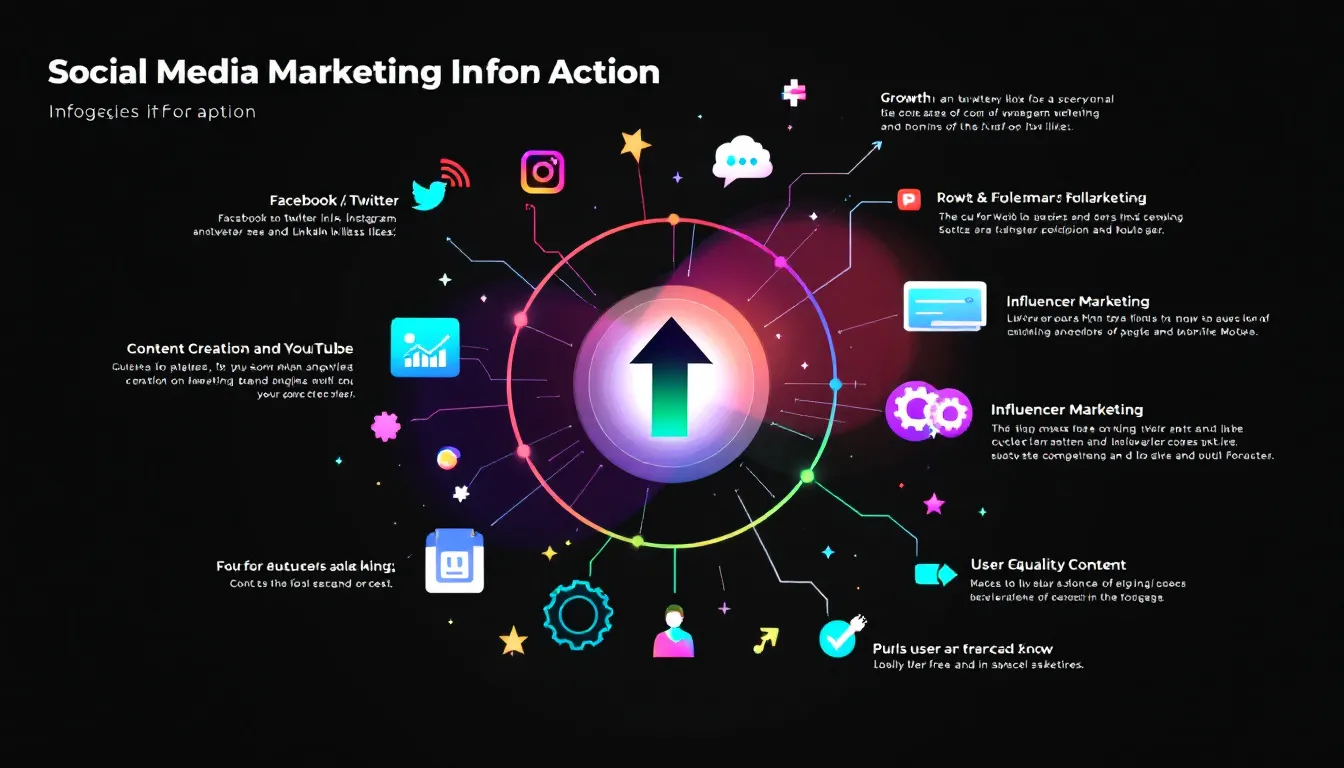Master the Five Pillars of Social Media Marketing for Success

Master the Five Pillars of Social Media Marketing for Success
Curious about what it takes to succeed in social media marketing? It comes down to mastering the five pillars of social media marketing: strategy, planning and publishing, audience engagement, analytics and reporting, and advertising. These pillars form the foundation of effective social media marketing. In this article, we’ll break down each pillar and show you how they can boost your brand’s online presence.
Key Takeaways
- Social media marketing is crucial for enhancing brand visibility and customer engagement, relying on high-quality content and real-time interaction.
- Mastering the five pillars of social media marketing—strategy, planning, audience engagement, analytics, and advertising—is essential for success.
- Emerging trends like short-form video, AI personalization, and social commerce are reshaping how brands connect with their audiences and drive sales.
Understanding Social Media Marketing

Social media marketing is the art of utilizing social media platforms to promote brands and engage audiences. It connects advertisers with billions of potential customers, significantly improving brand exposure and driving website traffic. The main goal here is to boost sales and enhance customer engagement, making it an indispensable part of any modern marketing strategy.
Effective social media marketing goes beyond mere advertising. It involves providing high-quality content that keeps users connected, thus increasing user activity and loyalty. The nature of social media also allows for real-time feedback from customers, fostering immediate interaction and deeper engagement.
In essence, a robust social media presence can greatly enhance customer loyalty and brand recognition.
The Five Pillars of Social Media Marketing

To thrive in today’s digital age, businesses must master the five core pillars essential for social media marketing:
- Strategy
- Planning and publishing
- Audience engagement
- Analytics and reporting
- Advertising
These essential pillars provide a structured approach to social media marketing, ensuring that all efforts are aligned with broader business goals and optimized for maximum impact.
Developing a Social Media Strategy
A solid social media strategy serves as a blueprint for all your actions, aligning digital marketing efforts with broader business goals. It starts with setting clear marketing objectives, which guide the entire campaign and offer performance benchmarks. Establishing SMART objectives (Specific, Measurable, Achievable, Relevant, Time-bound) can keep your well defined strategy focused and results-oriented.
Understanding your target audience is crucial. Social media platforms provide rich user data that allows you to define your audience without extensive market research. Analyzing demographic information and follower data helps tailor your content to meet their interests and needs.
When choosing social media platforms, consider where your target audience spends most social media platforms of their time. This ensures that your social media efforts are not only well-defined but also highly effective.
Effective Planning and Publishing
Consistency is key in social media marketing. To showcase your brand to potential customers, maintain a consistent presence on social media. Creating a content calendar is essential for planning your social media posts and ensuring your messages resonate with your audience. A well-organized social media calendar helps manage content scheduling and ensures that your posts align with audience preferences.
Good timing and frequency are also crucial. Optimal timing for engagement should be used for posting, and social media scheduling tools can help automate this process. However, always prioritize creating high-quality content that represents your brand well over merely posting frequently.
Align your posts with audience preferences and decide on the content type that best engages them. This way, your social media strategy becomes more effective and impactful.
Engaging with Your Audience
Active engagement with customers is the lifeblood of social media marketing. It turns one-way communication into interactive dialogues, fostering a community around your brand. Meaningful interactions, such as responding to comments, direct messages, and tags, can significantly increase conversations about your brand and attract more active users. This not only makes customers feel valued but also builds loyalty.
Quick replies to customer engagements are expected to maintain audience interest. Meeting these expectations helps build authority and trust with your audience. Monitoring mentions and direct messages using listening and engagement tools ensures you never miss an opportunity to connect with your followers.
High-quality and engaging content drives interaction and helps to curate relevant content that keeps your audience invested in your brand.
Leveraging Analytics and Reporting
Social media marketing provides businesses with built-in analytics tools to evaluate marketing success and refine strategies. Using these tools allows you to track performance indicators like engagement rates and conversion metrics effectively. Key performance indicators (KPIs) should align with business objectives to measure the success of social media campaigns accurately.
Regular analytics review is crucial for adapting strategies to enhance social media marketing outcomes. Analyzing google analytics and social media data helps identify trends and areas for improvement, which enhances campaign effectiveness.
By using data from multiple channels in one location, marketers can evaluate the effectiveness of their campaigns more comprehensively. This data-driven decision-making process is essential for optimizing future campaigns.
Utilizing Social Media Advertising
Social media advertising plays a crucial role in spreading brand awareness and helping to build brand awareness through paid advertising while reaching targeted audiences with social media ads on social media advertising platforms and various social media channels, including social media mentions on a social media platform and social media post.
Targeted ads can significantly enhance reach and engagement by tailoring campaigns to specific targeted audience demographics and behaviors.
Major types of social media advertising include:
- Static images
- Video ads
- Carousel ads
- Story ads
Each type provides unique engagement opportunities.
Utilizing diverse formats and targeted strategies in social media advertising can lead to increased brand awareness and boosted sales. By leveraging the various advertising options available on popular social media platforms, businesses can achieve their marketing goals more efficiently. This approach ensures that social media advertising efforts are both impactful and cost-effective.
Emerging Trends in Social Media Marketing

Consumer preferences and technological advancements are driving the evolution of social media marketing. These changes shape the strategies used in the industry. Staying ahead of emerging trends is crucial for maintaining a competitive edge. Key trends include the rise of short-form video content, AI-powered personalization, and the growth of social commerce.
These trends are reshaping how brands connect with their audiences and drive engagement.
Rise of Short-Form Video Content
Short-form video content has become the most engaging type of content on platforms like TikTok and Instagram. These videos quickly convey messages and appeal to audiences with shorter attention spans. The potential for content to go viral can significantly enhance brand visibility quickly.
Brands are now focusing on creating high-quality short-form videos to capture audience attention and drive engagement. This trend highlights the importance of being creative and concise in your content creation efforts, which is essential for establishing a strong brand identity.
Leveraging short-form video content allows brands to effectively communicate their messages and build a strong social media presence.
AI-Powered Personalization
AI-powered personalization is revolutionizing how brands target and engage with their audiences. AI tools analyze user behavior and preferences, enabling fast and efficient creation of personalized content. This leads to more effective marketing strategies and improved audience engagement.
The implementation of AI-driven personalization allows brands to deliver tailored experiences that resonate with individual users. By leveraging AI, businesses can enhance their social media marketing efforts and create more meaningful connections with their audience. This approach ensures that marketing strategies are data-driven and highly targeted.
Growth of Social Commerce
Social commerce integrates shopping features within social media platforms, providing seamless purchasing experiences. This trend significantly changes how consumers discover and purchase products. Features like live shopping events and in-app storefronts are becoming increasingly popular, allowing brands to interact with consumers in real-time during the buying process.
Examples of social commerce features include Instagram Shops and Facebook Marketplace, which enhance e-commerce opportunities for brands. By leveraging these features, businesses can boost sales and drive business growth.
Social commerce is an emerging trend that offers new ways for brands to connect with their audience and drive revenue.
Advantages and Challenges of Social Media Marketing

Social media marketing offers numerous advantages, such as cost-efficient advertising, community building, and free word-of-mouth promotion. It helps businesses build loyal customer communities that trust the brand. However, it also presents challenges like managing public criticism, dealing with changing algorithms, and addressing privacy concerns.
Negative feedback can spread rapidly on social media, posing a risk to a brand’s reputation if not managed properly. Measuring the return on investment can also be complex due to the difficulty in linking engagement metrics directly to sales.
Despite these challenges, the dynamic nature of social media marketing makes it a powerful tool for increasing brand awareness and driving business growth.
Building a Comprehensive Social Media Marketing Strategy

Building a comprehensive social media marketing strategy involves aligning social media goals with overall business objectives to achieve marketing goals, identifying and researching the target audience, and measuring and optimizing performance as part of a social strategy.
This approach ensures cohesive and effective marketing campaigns that drive results.
Aligning Social Media Goals with Business Objectives
Creating a solid social media marketing strategy involves defining clear objectives that align with overall business goals. Integrating social media goals with broader business aims ensures that marketing efforts are focused and measurable. This alignment enhances marketing coherence and effectiveness, contributing to overall business success.
By ensuring that social media objectives directly support larger business aims, businesses can achieve greater synergy between their marketing efforts and overall strategic goals. This approach ensures that social media marketing efforts are not only impactful but also aligned with the company’s mission and vision.
Identifying and Researching the Target Audience
Using audience insights from social media analytics helps marketers understand which demographics are engaging with their content. AI technologies can further enhance targeting by predicting user behaviors and tailoring content to individual preferences. This leads to more effective social media campaigns that resonate with the target audience.
Creating detailed user personas based on social media data helps in crafting tailored content that appeals to specific audience segments. By understanding the target audience and utilizing AI insights, brands can create more engaging and relevant content that drives brand loyalty and achieves marketing goals.
Measuring and Optimizing Performance
A successful social media marketing strategy requires clear goals, audience understanding, and consistent measurement of performance. Regular performance analysis allows brands to adapt their strategies to improve engagement and reach. Valuable insights from social media data can be utilized to refine strategies and optimize future campaigns.
Using social media analytics tools and key performance indicators (KPIs) helps businesses track their progress and make data-driven decisions. This continuous improvement process ensures that social media marketing efforts are effective and aligned with business objectives.
Regularly assessing performance metrics allows for better results and more efficient marketing strategies.
Summary
Mastering the five pillars of social media marketing is essential for any business aiming to thrive in today’s digital landscape. Developing a solid social media strategy, planning and publishing effectively, engaging with your audience, leveraging analytics, and utilizing social media advertising are all crucial components of a successful marketing approach. Each pillar plays a vital role in ensuring that your social media efforts are aligned with your business goals and optimized for maximum impact.
By staying ahead of emerging trends such as short-form video content, AI-powered personalization, and social commerce, businesses can maintain a competitive edge and drive engagement and sales. Despite the challenges that social media marketing presents, the advantages far outweigh the risks. With a comprehensive and well-executed social media marketing strategy, businesses can build strong brand awareness, foster customer loyalty, and achieve their marketing goals.
Frequently Asked Questions
What are the five pillars of social media marketing?
The five pillars of social media marketing are strategy, planning and publishing, audience engagement, analytics and reporting, and advertising. Focusing on these areas will really help you boost your online presence!
Why is a social media strategy important?
A social media strategy is crucial because it acts as a blueprint that aligns your marketing efforts with your business goals, helping you run focused and effective campaigns. Without it, you risk losing direction and missing out on potential engagement and results.
How can I improve engagement with my audience on social media?
To improve engagement with your audience on social media, focus on responding promptly to comments and messages, and share high-quality content that resonates with them. Building meaningful interactions will help cultivate loyalty and a vibrant community around your brand.
What are some emerging trends in social media marketing?
Short-form video content, AI-driven personalization, and the expansion of social commerce are shaping the future of social media marketing. Embracing these trends can really elevate your marketing strategy!
How do social media analytics tools help in optimizing marketing strategies?
Social media analytics tools act like your marketing compass, giving you insights on engagement and conversion rates. By understanding these metrics, you can fine-tune your strategies for better results in future campaigns.

